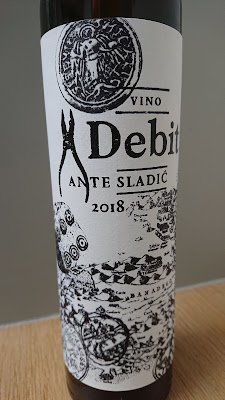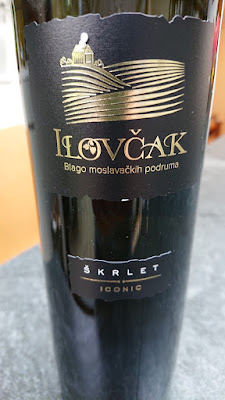In our last post 9.5% - 11.8% whites we concentrated on these lower alcohol wines which are always hard to find. They came from from the Basque country, England, France and Germany.
You may think it not a valid criterion to arrange wines by alcoholic content and maybe we are being didactic here but in our opinion, Abv. values are not given due prominence seeing as how they have a critical effect on calories, intoxication and frequently the expression or non-expression of the relevant grape variety. Lower alcohol seems to us to bring out typicity better than higher. For example, a Grignolino at 14% tends to become just another fruit bomb. Our beloved Ramisco grape of Colares also loses personality over say 12.5%.
Agree or not, we had to find a way of noting the various bottles we have been buying during lockdown. We hope this doesn't count as hoarding or panic buying. In fact online winebuying is one of the few bright spots in the market these days (up by over one-third apparently) and there seems to be plenty of supply with no one going without.
So in this post, we're listing reds as well as whites and going up to the dizzying height of 12.5% alcohol.
'Turca is a rare variety grown only in Veneto and Trentino, mainly around the hamlet of Araie, west of Feltre near Belluno and in the Valsugana.' There you have it according to D'Agata. If you haven't bought his 'Native Wine Grapes of Italy' yet, go buy it and don't delay. It is one of life's great pleasures to dodge from one entry to another.
Drnekusa
Jo Ahearne MW was wine buyer for Marks and Spencer and Harrods before taking off to Dalmacia (Croatia) to make wines from local grapes. 'Rosina' is made from 100% Drnekusa - a rare variety from the island of Hvar. Rumour has it this might be a rose. It's difficult to tell from the dark green bottle.
11.5%
White
Prie. It's not uncommon to come across Blanc de Morgex et de La Salle which is strange because it is made from the Prie grape that grows in some of the highest and most inhospitable terroirs in Europe. We say terroirs because many of the Prie vines are found on terraces, nooks, crannies and spots rather than vineyards and all together there are only about 25 ha of this ancient grape.
Prie has nonetheless managed to put itself about and a number of progeny have been discovered as far afield as Northern Spain. Lairen, Mayolet and Primetta pluspossibly Luglienga and Albillo Real.
Reds
Mustilli is a Piedirosso from the comune of Sant'Agata de' Goti in the province of Benevento/Beneventano in Campania. Piedirosso is the signature grape of Campania together with Aglianico and Falanghina. We've always loved Piedirosso. This one is rare at 11.5%
Slarina. Douglas Wregg of 'Les Caves de Pyrene' writes;
'Fabrizio Iuli...planted more and more vineyards (9 ha in total) and cultivates Nebbiolo and Pinot Noir, but his speciality is Barbera. Recently, he has begun to rediscover other autochthonous varieties and to that end is producing some fascinating examples of the lesser known Grignolino (Natalin), Slarina (La Rina) and Baratuciat (Barat).
It seems likely that Italian viticultural authorities removed Slarina (amongst others) from the registry of recognised varieties during the country’s post-war viticultural renaissance because of its inconsistent productivity...'
You won't find Slarina either in D'Agata or in 'Wine Grapes.'
12%
Whites
Bianco D'Alessano is one of Slotovino's favourite grape varieties. We make no apologies for writing about it whenever we have the opportunity. For sure some are better than others but at its best this is a grape that should be much better known.
Debit. High yielding variety supposedly named after its ability to pay debts. Not related to Pagadebit (Puglia), also high yielding. Strangely. 'Wine Grapes' describes Debit as a 'Vine producing alcoholic wine.' It just shows that Abv. is a choice. Ante Sladic has chosen to make this version at 12%.
Goldriesling. An early Alsacian hybrid from Riesling and an as yet unidentified variety. We are rather fond of Goldriesling having enjoyed a memorable chilled glass on a sweltering day in Radebeul, Dresden on one occasion. It is now a speciality of that area but we have succeeded in planting a few vines in the Thames Valley (the only ones in the UK?) which produce nice sweet berries when the birds don't get them. Interestingly, our Goldriesling suffered from mildew of one kind or another until we grubbed up the neighbouring rows of Bacchus. Now they seem OK.
Schloss Proschwitz is one of our preferred producers in the neglected area of Sachsen, the other being Schloss Wackerbarth.
The back label says Greco Bianco but what actually is the grape? D'Agata tells us most Greco in Calabria ia Malvasia di Lipari. Since this one is from Ciro however, it might be Guardalvalle. There are others (D'Agata says 'take an aspirin').
Back in 2012 we had tasted Terret Blanc at the Real Wine Fair in three different bottles and susequently admitted it to our grape varieties' Hall of Fame. It may not be world-shattering but it is a pleasant addition to the choice of white wines and restaurants should bear it in mind when they have run out of Picpouls, Marsannes, Roussanes and what have you.
Debina. Domaine Glinavos of Zitsa, Epirus, Greece's most remote wine growing area. Debina is the only official variety there although others are planted. It is said to have been grown since the 7th century and Byron appreciated it on his way through saying “a superb white wine of which Abbot Gregorios was very proud”.
Debina has its difficulies both in viticulture and winemaking but the best examples are considered fres, elegant and drinkable which is what we ghave here.
This was our chance to taste a Sideritis wine. Why Iron? Because Sidero = iron in Greek. the Sideritis grape has pink skin and is used as a table grape and for distilling as well as making white wine as in this example by the Achaeon winery, Achaia, central Greece. Sideritis is certainly individual and original. We were glad to have tasted it but don't feel an irresistable urge to repeat the experience.
Picapoll. Picapoll Blanco (there is a Picapoll Negro variety) is described as a minor Catalan variety that may be the same as France's Clairette Blanche. (Wine Grapes). 'The DNA profiles are said to be almost the same but it is not yet clear whether Picapoll Blanco is simply a clonal variation on Clairette or a distinct yet very cloesly related variety (Vouillamoz).' (Wine Grapes again.).
We have enjoyed Catalunian Picapoll way more than French Clairette which to us tastes nothing like it so we'd like to think it is unique.
Jo Ahearne MW makes a blend of Kuc, Bogdanusa and Posip called 'Wild Skins' also from Hvar. Kuc is a synonym for the Dalmatian variety Trbljan which was erroneously thought to be Trebbiano. Bogdanusa is described below as a monovarietal and Posip is one of Dalmacia's most highly considered varieties, grown mainly on Korcula. This is a 'maceration' wine. Orange?
Reds
Trepat. Another of the Cava grapes, Trepat makes lovely light reds which we think should be better known and available on restaurant winelists for example. 'Wine Grapes' notes it is 'typically fruity, lightly structured, dominated by fresh red berries (strawberries, raspberries), hay, and a certain spiciness (cinnamon). A recommendation or what?
Chambourcin. We just adore Chambourcin which you may find strange because there is not one 'noble' variety in its ancestry.
Seyve-Villard 12-417 where Seyve Villard 12-417 is a Seibel 6468 x Subereux cross (for the complete pedigree see Brianna for Seibel 6468 and Prior for Subereux).
and
Chancellor (a complex hybrid obtained by crossing Seibel 5163 x Seiber 880 (see Prior for the complete pedigree of Chancellor).
'Wine Grapes.'
If they can produce a grape variety as great as Chambourcin in this complex way there has to be hope for a Corona Virus vaccine.
Blauer Portugieser has had a bad rap because it is a high-yielding vine and there may be some 'rather dull low-acid wines' (Wine Grapes) around.
You could say there may be some rather dull wines around from most grapes so that is a bit unfair. Surprisingly it is the 3rd most planetd red variety in Austria from where it is thought to have originated. It is definitely not a Portuguese variety.
For us it has character, lightness and charm. We put it alongside Poulsard, Pineau D'Aunis, Grignolino and Trepat as a highly drinkable wine of character.
Dornfelder. Dornfelder is descended from Portugieser as well as Pinot Noir Precoce, Schiava Grossa and Blaufrankisch and is described as 'The most successful of the modern German crosses, making dark, velvety wines.
It was only authorised in 1980 since when it has been widely planted in Germany and also to a lesser degree in Switzerland, England, the Czech republic. USA, Brasil and Japan.
12.5%
Whites
Gegic is the speciality of Pag, an island off the coast of Dalmatia. It is an irregular ripener which means it is declining.
Bogdanusa is mainly from the island of Hvar off the Dalmatian coast. Bogdanusa is considered as making light fresh white wines. ('Wine Grapes').
Skrlet comes from Croatia and the name is said to be a corruption of the German 'scharlach' = scarlet - in this case because of the red spots on the grape skins, remeniscent of scarlet fever. That should gain this variety a lot of friends, don't you think?
Again, light, fresh and delicate. Skrlet was on the road to extinction before being brought back from the brink by a handful of makers. We applaud them.
Minutolo or Fiano Minutolo. We read in D'Agata it has been grown in Puglia since 1200. By 2000, it had become a minor curiosity but was revived by Lino Carparelli of the director of the Cantina Sociale Locorotondo and then head winemaker of Torrevento. It has become so popular now that quite possibly more Minutolo wine is made than there are Minutolo vines.
Roter Veltliner - we can't stop enthusing about this lovely variety - totally independent of Gruener and just as good if not better for our money.
So good, here's another one.
A new label for Simpson's Pinot Meunier vinified white. We enthused about this last year and include it so you can find it again under the moniker 'On the QT'. This expression may come from the Music Hall where it comprised a line from Ta-ra-ra-boom-de-ay;
A sweet Tuxedo girl you see,
Queen of swell society,
Fond of fun as fun can be
When it's on the strict Q.T.
Maybe Simpsons didn't have precisely this in mind but they have gone from producing sparkling to producing still wine possibly via a stage when producing still wine was a bit furtive? We have hailed this white Pinot Meunier as one of the best English table wines ever and an excellent wine by world standards. It's reasonably priced too. Hooray!
Reds
Schwarzriesling is Pinot Meunier. This one is vinified red.
Trollinger, aka Vernatsch, Schiava from the Graf Neipperg estate in Wuerttemberg. The Neippergs also own or co-own Chateau Canon La Gaffeliere in Saint Emilion and other Bordeaux properties such as La Mondotte, Clos l'oratoire, D'Aiguilhe, Peyraud, Soleil, Clos L'Oratoire, Marsalette and Guiraud in Bordeaux and Enira in Bulgaria. Quite an empire.
Plavina is a 'Dark skinned offspring of Tridibdrag (Zinfandel) producing light reds the length of the Dalmatian coast.' (Wine Grapes,')
We love Ante Sladic's labels.Informative, clear - great graphics.
 |
| Dalmacija Primorska - the Dalmacian coast |




























































No comments:
Post a Comment